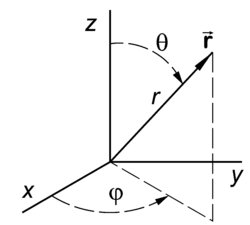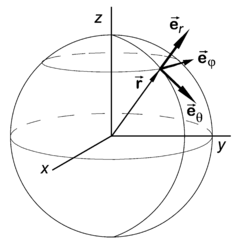Spherical polar coordinates
In mathematics and physics, spherical polar coordinates (also known as spherical coordinates) form a coordinate system for the three-dimensional real space . Three numbers, two angles and a length specify any point in . The two angles specify the position on the surface of a sphere and the length gives the radius of the sphere.
Spherical polar coordinates are useful in cases where there is (approximate) spherical symmetry, in interactions or in boundary conditions (or in both). In such cases spherical polar coordinates often allow the separation of variables simplifying the solution of partial differential equations and the evaluation of three-dimensional integrals.
Definition
Let x, y, z be Cartesian coordinates of a vector in , that is,
where are unit vectors along the x, y, and z axis, respectively. The x, y, and z axes are orthogonal and so are the unit vectors along them.
The length r of the vector is one of the three numbers necessary to give the position of the vector in three-dimensional space. By applying twice the theorem of Pythagoras we find that r2 = x2 + y2 + z2.
Let θ be the colatitude angle (see the figure) of the vector . In the usual system to describe a position on Earth, latitude has its zero at the equator, while the colatitude angle, introduced here, has its zero at the "North Pole". That is, the angle θ is zero when is along the positive z-axis. The sum of latitude and colatitude of a point is 900; these angles being complementary explains the name of the latter. The colatitude angle is also called polar or zenith angle in the literature.
The angle φ gives the angle with the x-axis of the projection of on the x-y plane. The angle φ is the longitude angle (also known as the azimuth angle).
Note that the projection has length r sinθ. The length of the projection of on the x and y axis is therefore r sinθcosφ and r sinθsinφ, respectively. In summary, the spherical polar coordinates r, θ, and φ of are related to its Cartesian coordinates by
Given a spherical polar triplet (r, θ, φ) the corresponding Cartesian coordinates are readily obtained by application of these defining equations.
The figure makes clear that 00 ≤ φ ≤ 3600, 00 ≤ θ ≤ 1800, and r > 0. The coordinate surfaces are:
- r constant, all θ and φ: surface of sphere.
- θ constant, all r and φ: surface of a cone.
- φ constant, all r and θ: plane.
The computation of spherical polar coordinates from Cartesian coordinates is somewhat more difficult than the converse, due to the fact that the spherical polar coordinate system has singularities, also known as points of indeterminacy. The first such point is immediately clear: if r = 0, we have a zero vector (a point in the origin). Then θ and φ are undetermined, that is to say, any values for these two parameters will give the correct result x = y = z = 0. Compare this to the case that one of the Cartesian coordinates is zero, say x = 0, then the other two coordinates are still determined (they fix a point in the yz-plane). Two other points of indeterminacy are the "North" and the "South Pole", θ = 00 and θ = 1800, respectively (while r ≠ 0). On both poles the longitudinal angle φ is undetermined.
So, when going from Cartesian coordinates to spherical polar coordinates, one has to watch for the singularities, especially when the transformation is performed by a computer program. Given x, y and z, the consecutive steps are
Other convention
The convention introduced above (θ for the colatitude angle, φ for the azimuth angle) is used universally in physics. In mathematics it is very widespread, too. To quote a few mathematics books that apply it: Abramowitz and Stegun[1] p. 332, Whittaker and Watson[2] p. 391, Courant and Hilbert[3] p.195, and Kline[4] p. 527.
Some American mathematical textbooks, e.g. Apostol[5], interchanged φ and θ, apparently for pedagogical reasons, as can be gathered from the following quotation of Eric Weisstein:
In this work, following the mathematics convention, the symbols for the radial, azimuth, and zenith coordinates are taken as r, θ, and φ, respectively. Note that this definition provides a logical extension of the usual polar coordinates notation, with θ remaining the angle in the xy-plane and φ becoming the angle out of that plane. The sole exception to this convention in this work is in spherical harmonics, where the convention used in the physics literature is retained (resulting, it is hoped, in a bit less confusion than a foolish rigorous consistency might engender).
The American textbook convention is followed by the Maple algebraic program package and also by the numerical package Matlab. (Matlab also redefines the zero of the colatitude angle to be on the equator). The Mathematica package follows the physics convention.
Unit vectors
(To be continued)
References
- ↑ M. Abramowitz and I. A. Stegun, Handbook of Mathematical Functions, Dover, New York, 1965.
- ↑ E. T. Whittaker and G. N. Watson, A Course of Modern Analysis, Cambridge UP, (1965).
- ↑ R. Courant and D. Hilbert, Methoden der mathematischen Physik I, Springer Verlag Berlin (1968).
- ↑ M. Kline, Mathematical Thought from Ancient to Modern Times, Oxford UP, New York (1972)
- ↑ T. M. Apostol, Mathematical Analysis, Addison-Wesley Reading Mass, (1974) p.419











